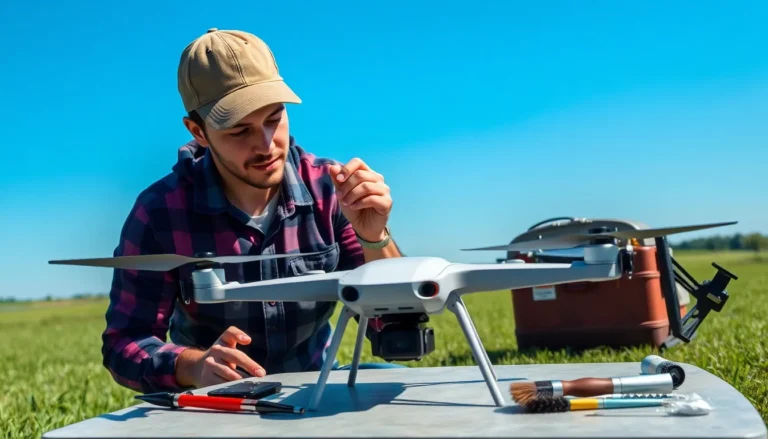In a world where the only thing growing faster than technology is the extinction rate of species, biodiversity technology steps in like a superhero with a cape made of data. Imagine a high-tech toolbox designed to save the planet’s flora and fauna while keeping the human race entertained. From drones mapping ecosystems to apps identifying species faster than a toddler can say “dinosaur,” this tech isn’t just cool—it’s crucial.
Biodiversity technology isn’t just for scientists in lab coats anymore. It’s for everyone who’s ever wondered how many bees it takes to pollinate an apple tree or how to save the last remaining unicorn (okay, maybe not unicorns, but you get the point). By harnessing cutting-edge innovations, we can protect our planet’s rich tapestry of life while having a little fun along the way. Let’s dive into how this tech is reshaping our approach to conservation and making the world a greener place.
Table of Contents
ToggleOverview of Biodiversity Technology
Biodiversity technology encompasses the innovative tools and methods aimed at understanding, monitoring, and conserving biodiversity. This technology plays a vital role in tackling the extinction crisis and promoting ecosystem health.
Definition and Importance
Biodiversity technology refers to the use of advanced tools to assess and protect biological diversity. These tools allow for the collection and analysis of data related to various species, habitats, and ecosystems. Importance lies in their ability to aid conservationists in making informed decisions based on precise and real-time data. Species monitoring becomes more effective with technologies such as remote sensing and environmental DNA analysis. Engaging the public in conservation efforts is also crucial, as more individuals can participate in data collection and awareness initiatives using user-friendly apps. Supporting biodiversity through this technology ensures a healthier planet and resilient ecosystems.
Current Trends in Biodiversity Technology
Current trends show an increase in the use of artificial intelligence and machine learning in biodiversity assessment. Many organizations deploy drones for aerial surveys to gather critical ecological data efficiently. Smartphone applications enable citizen scientists to report species sightings, creating large data sets for researchers. Conservation organizations leverage social media platforms to disseminate information and mobilize community involvement. Additionally, innovations in genetic sequencing help track species’ health and genetic diversity. These trends indicate an ongoing shift toward more inclusive and technology-driven conservation efforts.
Applications of Biodiversity Technology

Biodiversity technology features various applications that significantly impact conservation and agriculture. These applications serve to enhance understanding and management of ecosystems.
Conservation Efforts
Innovative tools assist in monitoring wildlife populations. Drones capture aerial images, providing insights into habitat conditions and species distributions. Apps empower citizen scientists to track species sightings and report data in real-time. Remote sensing technologies enable researchers to assess environmental changes like deforestation. Environmental DNA analysis plays a crucial role in identifying species presence through soil and water samples. Collectively, these efforts enable more informed conservation strategies and foster community engagement in preservation initiatives.
Agricultural Practices
Technological advancements also revolutionize agricultural practices. Precision agriculture employs tools such as satellite imagery to enhance crop productivity while minimizing environmental impacts. Smart sensors monitor soil health and moisture levels, allowing farmers to optimize resource use. Mobile applications provide farmers with real-time data on pest outbreaks and disease risks, facilitating timely interventions. Biodiversity-friendly farming practices promote habitat for beneficial organisms, enhancing ecosystem services. Together, these technologies contribute to sustainable farming, balancing food production with conservation needs.
Innovations Driving Biodiversity Technology
Biodiversity technology drives innovations that address the extinction crisis and enhance ecosystem health. Two key areas of advancement are remote sensing and data analytics.
Remote Sensing and Monitoring
Remote sensing technology plays a crucial role in monitoring biodiversity. Drones equipped with high-resolution cameras provide aerial imagery, revealing habitat conditions and species distributions. Scientists utilize satellite imagery to track environmental changes, including deforestation and land use alterations. This technology enables quick assessments of fragile ecosystems, supporting conservation efforts effectively. Wildlife researchers gather data on species populations without disturbing habitats, increasing the overall success of monitoring projects.
Data Analytics and Machine Learning
Data analytics combined with machine learning transforms how biodiversity data is analyzed. Algorithms identify patterns in species distributions and ecological interactions, giving insights for effective conservation strategies. Organizations employ machine learning to process large datasets, making it easier to predict species behavior and potential extinction threats. Apps designed for citizen scientists collect valuable data on species sightings, which contribute to expansive databases. Statistically significant correlations emerge from comprehensive analysis, allowing stakeholders to make informed decisions.
Challenges and Limitations
Biodiversity technology faces numerous challenges that can hinder its effectiveness. Addressing these barriers is essential for advancing conservation goals.
Technical and Financial Barriers
Technical difficulties arise from the rapid evolution of biodiversity technology. Many tools require expertise for effective use, limiting accessibility. Financial barriers often emerge, particularly for smaller organizations lacking funding. Initial costs for advanced technologies can be prohibitive, impacting widespread implementation. Limited budgets can restrict participation in conservation efforts, perpetuating gaps in data collection. Collaborative efforts among organizations can mitigate these issues, allowing resource sharing to ensure broader access to necessary technologies.
Ethical Considerations
Ethical questions often arise in biodiversity technology applications. Utilizing citizen science raises concerns about data accuracy and privacy. Participants’ contributions can vary, leading to inconsistent data quality. Indigenous communities may also express concerns over the ownership and use of traditional knowledge. Transparency in data collection methods is crucial for maintaining trust among stakeholders. Stakeholders should prioritize ethical considerations while designing technology to ensure a balanced approach to conservation.
Future Prospects of Biodiversity Technology
The future of biodiversity technology appears promising, with continuous advancements enhancing conservation efforts.
Emerging Technologies
Innovations like artificial intelligence and machine learning increasingly support biodiversity assessments. Drones equipped with high-resolution cameras capture real-time images of habitats, providing critical data on wildlife populations. Smartphone apps encourage citizen scientists to log species sightings, promoting community involvement in conservation. Environmental DNA analysis allows researchers to detect species from soil and water samples, enhancing monitoring efforts. Remote sensing tools assess changes in land use, informing conservation strategies. Overall, emerging technologies not only streamline data collection but also foster greater public engagement in preserving biodiversity.
Policy and Governance Implications
Policies shaping biodiversity technology must address accessibility and equity. Regulations often lag behind technological advancements, creating gaps that limit smaller organizations’ participation. Ethical considerations regarding data accuracy and privacy also require attention, ensuring citizen science practices protect sensitive information. By prioritizing transparency in data collection and sharing, governance can build trust among stakeholders. Collaborative frameworks between governments, NGOs, and Indigenous communities can facilitate innovative conservation approaches. Strong policies can amplify the positive impacts of technology, balancing conservation needs with public engagement and ecological sustainability.
Biodiversity technology stands at the forefront of conservation efforts. Its innovative tools empower individuals and organizations alike to engage in protecting the planet’s diverse ecosystems. As technology continues to evolve, it opens new avenues for monitoring and preserving biodiversity.
The integration of artificial intelligence and community-driven data collection enhances the ability to respond to environmental challenges. While there are hurdles to overcome, such as accessibility and ethical concerns, the potential benefits are immense.
By fostering collaboration among various stakeholders, biodiversity technology can lead to more effective conservation strategies. The future holds promise for a more sustainable balance between human activity and ecological health, ensuring the survival of countless species for generations to come.










